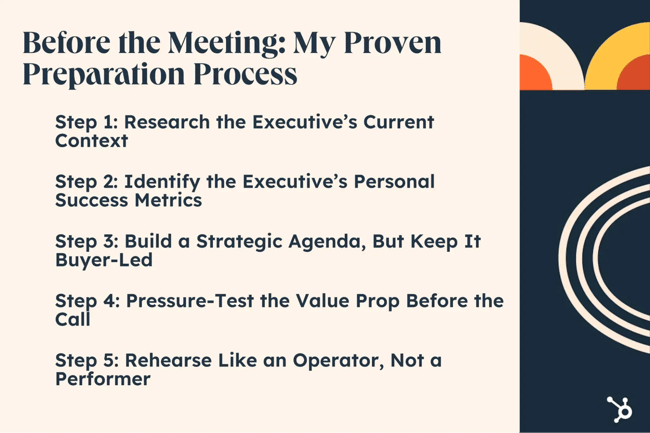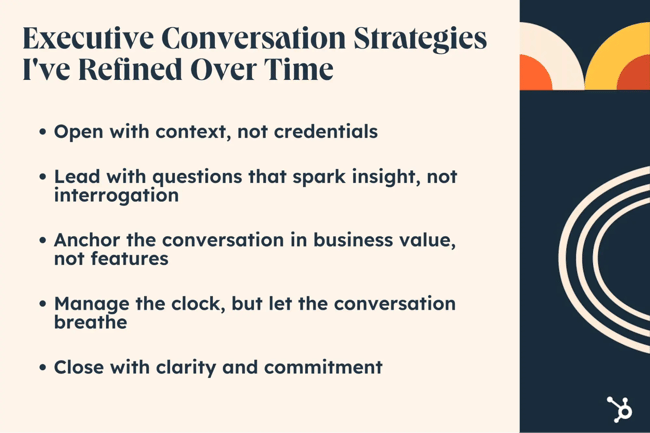
Most reps aren’t prepared to sell to C-level executives. Here’s my honest take: Most salespeople are overprepared for objections and underprepared for business conversations.
They rehearse demos instead of researching pressure points. They come armed with product knowledge, but not enough market insight. And they try to impress executives when they should be enabling decisions.
In this post, I’ll reveal what it really takes to sell to execs. That includes how to prepare like a strategist, not a seller, and hope to drive action in under 30 minutes. I’ll also share the mistakes I made, the frameworks I use (including multi-stakeholder alignment models), and the exact psychology I apply when stepping into the room with someone who signs the checks.
But first, here’s a little bit about my journey with executive selling.
Table of Contents
- My First C-Level Sales Meeting
- Understanding the Executive Mindset: What I’ve Learned From Hundreds of C-Suite Meetings
- Before the Meeting: My Proven Preparation Process
- During the Meeting: Executive Conversation Strategies I’ve Refined Over Time
- Making the Executive Sale
My First C-Level Sales Meeting
I’ll never forget the first time I sold to a C-level executive. It wasn’t a Zoom call or a casual check-in. It was a formal boardroom meeting at a multinational company in São Paulo. There were five people in the room — one CEO, one CFO, two directors, and me.
I had rehearsed my pitch twenty times. I had the deck, the talking points, the case studies, even the objection-handling matrix I’d built the night before. I walked in ready to prove value.
Ten minutes in, I realized I was losing them.
They weren’t asking about product features. They weren’t reacting to benchmarks. They weren’t interested in “what our solution does.” They wanted to talk about strategy. Market positioning. Risk mitigation. Internal politics. And when the CFO asked, “What are you helping us avoid next quarter?” I didn’t have a crisp answer. I froze.
I didn’t lose the deal that day. But I didn’t win their trust either.
And that’s when it hit me: selling to executives isn’t about presenting solutions. It’s about proving strategic relevance.
Since then, I’ve sold to hundreds of C-level decision-makers across five continents—from SaaS founders in New York, to CIOs in Dubai, to CFOs in Mexico City, and managing directors in London. I’ve closed over $40 million in enterprise contracts, and I’ve coached SDRs and AEs who struggled to break into the C-suite—until they started shifting from seller to strategic partner.
As Brent Adamson (co-author of The Challenger Sale) once said, “The best sellers don’t just deliver insight. They disrupt thinking.” That’s what this guide is about: equipping you with the mindset and tools to stop pitching and start leading executive conversations with clarity, control, and commercial impact.
Understanding the Executive Mindset: What I’ve Learned From Hundreds of C-Suite Meetings
If you walk into a C-level meeting thinking it’s just a higher-stakes demo, you’ve already lost.
I learned this the hard way.
Years ago, I landed a rare opportunity: a one-on-one with the CEO of a billion-dollar logistics company in LATAM. I’d done the research, practiced my opener, even rehearsed objections. But five minutes in, he leaned back in his chair, raised his eyebrows, and said something that changed my approach forever:
“That’s all fine — but, tell me why this matters now.”
Not what my product did. Not how it worked. But why now? And more importantly, why him?
That moment cracked something open for me. Because selling to C-level executives isn’t about transferring information. It’s about transferring strategic urgency.
Here’s the core shift: Executives don’t care about how your solution works. They care about how it protects or advances their priorities.
C-Level Thinking Is Rooted in Tradeoffs and Timing
Over the past 17 years, I’ve sold to CEOs, CFOs, CIOs, CMOs, and Heads of Strategy worldwide. There’s a pattern I see every time.
Executives think in frameworks. They make decisions based on tradeoffs. They are not interested in features. They’re interested in outcomes. They don’t want to know what’s possible. They want to know what’s probable.
That means when you walk into a C-level sales conversation, your job is not to educate them on your solution. It’s to connect the dots between their strategic priorities and your business impact.
According to a Forrester report, 62% of executive buyers say sellers lack insight into their business. That’s the gap. And that’s the opportunity.
You Need to Speak the Language of Risk and Return
Most sales conversations operate at the tactical level. Executive sales conversations live at the intersection of risk, revenue, cost, and timing.
When I sell to operational leaders, I talk in terms of efficiency gains, time-to-value, and change management. When I meet with a CFO, I anchor around the cost of delay, margin protection, and budget prioritization. When it’s the CEO, I zoom out even more: market timing, competitive threat, and category differentiation.
You’re not just selling a product. You’re helping them place a bet. And, the clearer you are about the upside and the downside, the more trust you earn.
Here’s the Controversial Take: Scripts Don’t Work in the C-Suite
I know that goes against a lot of sales training. But, I stand by it.
Scripts are great for new reps. They help with structure. However, when I’m walking into a room with a C-level decision-maker, I toss the script. That’s because executives can smell rehearsed from a mile away.
Instead, I prep using mental models and deal-specific scenarios. I ask myself:
- “What pressure is this person under right now?”
- “What’s the internal political risk if they say yes or say no?”
“How can I help them look smart in front of their board?”
That’s what real preparation looks like at this level. As Anthony Iannarino puts it: “You’re not there to sell a product. You’re there to sell a better future.”
If you can’t define what that future looks like in terms they care about, you’re not ready for the meeting.
The Executive Mindset Is Fast — But Not Rushed
This is a nuance most reps miss: C-levels move fast, but they don’t make rushed decisions.
That means you need to lead the meeting with clarity, not clutter. Open with the insight. Lead with the risk. Map the path forward early.
In my highest-converting executive meetings, I always do three things in the first 90 seconds:
- Reframe the context in their world.
- Clarify the outcome, I believe they care most about.
- Ask a strategic question that proves I’ve done my homework.
When I follow that rhythm, I move from vendor to thought partner — fast. Once you’ve earned that position, the entire conversation changes.
Before the Meeting: My Proven Preparation Process

You don’t get a second shot with a C-level executive. That’s why I treat every executive meeting like a campaign — high stakes, no fluff, and zero guesswork.
Over the years, I’ve built a prep process that’s helped me close $40M+ in enterprise deals across LATAM, the Middle East, and the U.S., and more than $406K in early-stage revenue for startups that had no brand equity to lean on. I’ve used this same framework whether I was walking into the CEO’s office at a Fortune 500 company or jumping on a VC-funded founder’s calendar for a 15-minute call.
Below is my playbook for preparing. It’s not about Googling their name five minutes before the meeting. It’s about showing up as someone who belongs in the room.
Step 1: Research the Executive’s Current Context
This isn’t surface-level LinkedIn scanning. I go deep.
I start by answering three core questions:
- What macro challenge is this exec facing right now?
- What internal priority might this solution touch?
- What would make this conversation feel worth 30 minutes on their calendar?
I review the company’s most recent press releases, investor updates, and leadership transitions. I read the executive’s interviews or authored content (LinkedIn posts, podcast appearances, earnings calls). If they’ve said, “We’re focused on expanding in LATAM,” then you can bet my opener references go-to-market localization — because I’ve done that in four languages.
When I walk in, already showing that understanding, the dynamic shifts. I’m no longer an interruption. I’m a strategic input.
Remember: Context is the new closing technique. I know most sales teams skip this step and wonder why they get ghosted.
Step 2: Identify the Executive’s Personal Success Metrics
C-suite leaders don’t buy tools. They buy outcomes. And, those outcomes are personal. A CFO might care about cost avoidance this quarter. A CRO might be under pressure to fix a pipeline hygiene issue. A COO might be tied to operational KPIs like time-to-resolution or onboarding cost.
I tailor my messaging around what they care about, not what I want to sell.
Here’s what I ask myself:
- What metric are they being evaluated on this quarter?
- How does my solution make them look smarter, faster, or more future-ready?
- What’s the unspoken internal risk if they make the wrong call?
I even built a cheat sheet with:
- Their top 3 potential goals
- Their likely blockers
- 1 insight that connects what I do to what they’re trying to achieve
Bonus: I write my first-line cold opener using this prep. That means even if I never land the meeting, my outreach still positions me as thoughtful, not transactional.
Step 3: Build a Strategic Agenda, But Keep It Buyer-Led
Executives hate two things: wasted time and vague meetings. So, I set a clear, tight agenda before the call, then frame it in a way that serves them, not me.
Here’s my structure:
- “I’d love to start by understanding how you’re approaching [priority X] this quarter.”
- “From there, I can share what we’ve seen work in similar companies in [industry].”
- “If there’s interest, I can walk through a few outcomes we’ve helped others achieve—and what that might look like for your team.”
I send this agenda ahead of time in my calendar invite and email follow-up. Why? Because it primes the call, lowers resistance, and increases show rates (mine are consistently under 18%).
Controversial take: I don’t walk into exec meetings with a discovery sheet. I walk in with a narrative. And, that narrative starts with the exec, not with me.
Step 4: Pressure-Test the Value Prop Before the Call
This is one most sellers skip, and it costs them the deal.
Before any C-level meeting, I challenge my own pitch:
- “If this executive asked, ‘Why now?’, do I have a one-sentence answer?”
- “Can I explain the impact in their language, not mine?”
“Is there a quantifiable risk of not acting?”
If I can’t answer those questions clearly, I go back and tighten the value proposition.
Example: Instead of saying, “We help teams streamline collaboration.” I say, “We helped a distributed ops team reduce project delays by 22% in Q1—without adding headcount or changing their workflow.”
As the Challenger model teaches, insight wins over information. And executives? They pay attention when the insight costs them something if ignored.
Step 5: Rehearse Like an Operator, Not a Performer
I don’t memorize a script. I rehearse my flow.
I mentally walk through the meeting like an athlete visualizing a race. I prep for likely objections (“We already have a solution,” “We’re in budget review”) and match them with business-first counters.
I review the agenda and the call plan out loud. I say my opener to a peer, or record myself and play it back. If I weren’t impressed hearing it from someone else, I would rewrite it.
I’ve coached dozens of reps who stumbled through their first exec meeting because they thought “winging it” was confident. It’s not. It’s reckless.
Executives respect prep. And they can tell who’s done it by the second sentence out of your mouth.
During the Meeting: Executive Conversation Strategies I’ve Refined Over Time

Let’s be real: C-level conversations aren’t like your average sales call. I’ve had to learn that the hard way. They don’t care about your product. They care about how it protects or advances the business. Period.
And over the last 17 years, I’ve refined a few critical strategies that have helped me stay in the room, win their trust, and drive real executive conversations that convert. Let me break it down for you step by step.
Open with context, not credentials
When I first started selling to executives, I used to think I had to prove myself in the first 60 seconds. I’d rattle off my experience, my company’s logos, and my metrics. Guess what? They didn’t care.
What shifted everything for me was realizing that executives value relevance over resumes.
So now, I open with this: “Here’s what I’m seeing in your space right now — and here’s why I reached out.”
I center the conversation on their world, not mine. Their timing, not my targets. And that one change gets me better engagement in the first 2 minutes than any pitch deck ever has.
Data backs this up: A Harvard Business Review study found that 90% of C-suite execs say they “never” respond to cold outreach that isn’t personalized to their business context.
Lead with questions that spark insight, not interrogation
Here’s something I’ll debate any day: The best executive sellers don’t ask more questions. They ask better ones.
When I’m in the room with a CEO, I don’t ask about their “current tech stack.” I ask, “What’s one initiative this quarter that feels high-risk but unavoidable?” Because that’s what’s keeping them up at night. And when they answer, I listen like a strategist, not just a seller.
Here are three question frameworks I’ve found powerful in C-level meetings:
- Impact Framing: “If this doesn’t get solved, what’s the downstream effect six months from now?”
- Comparison Insight: “What’s changed since the last time your team tried solving this?”
Ownership Trigger: “If this works, who benefits the most, and who gets the credit?”
These questions position you as a business partner, not a product pusher.
As The Challenger Sale co-author Brent Adamson says, “The best reps teach customers something new about their business.” That’s your job in a C-level meeting: not to discover problems, but to reframe them.
Anchor the conversation in business value, not features
When I meet with execs, I reframe everything in their language:
- “This isn’t about automation—it’s about reducing human error by 38% in your current workflow.”
- “This isn’t about dashboards—it’s about faster decision-making across departments.”
I bring metrics, ROI, and industry benchmarks. And when I don’t have exact numbers, I offer assumptions based on similar companies: “Based on what we saw with [Peer Company], this might look like a 12–18% improvement in your customer onboarding time.”
Here’s my golden rule: If the value isn’t framed in their scoreboard, it doesn’t land.
Manage the clock, but let the conversation breathe
I used to cram everything into a 30-minute slot, thinking more info = more value. But the truth? C-level buyers don’t want a firehose. They want a signal.
Now, I do three things every time:
- Set clear checkpoints: “We’ve got 30 minutes. Want to spend the first 10 unpacking the challenge?”
- Build in space: I leave room for silence. Executives often pause to think, and that’s where the gold lives.
- Adapt in real-time: If we hit a moment of alignment, I go deeper—even if that means skipping the demo. I prioritize impact over agenda.
And I always ask, “Is this direction helpful—or should we pivot to what’s most top-of-mind for you?”
This single question signals respect, adaptability, and strategic alignment.
Close with clarity and commitment
Here’s where most reps fumble: they end the meeting with “I’ll follow up with some next steps.” That’s weak. Executives don’t want homework. They want decisions.
So I close by recapping what we uncovered and aligning on what’s next:
- “Based on today, here’s what I heard: [Recap pain + impact]. If we’re aligned on solving this, the next step is [insert next step]. Sound good?”
This approach gives them the power, but it gives me the momentum.
When I started using this format, my post-meeting drop-off rate decreased by over 40%. Because the exec left the meeting knowing exactly where we were going — and why it mattered.
Making the Executive Sale
One of the biggest shifts in my career didn’t come from a new pitch deck or a clever line in a cold call. It came from sitting across from a CEO who said something I’ll never forget, “I don’t need another vendor. I need someone who can help me think better.”
That hit me hard. Because up until that moment, I thought I was doing everything right. I had the slide deck. I had the numbers. I had the case studies polished and ready. But what I didn’t have was the right to lead the conversation at the executive level.
That meeting didn’t end with a deal. It ended with a wake-up call. I walked away realizing that selling to C-level executives isn’t just another stage in the funnel. It’s an entirely different game.
So no, I don’t show up to impress C-level executives anymore. I show up to serve them. I show up with insight. With questions. With respect for their time — and a strategy to make it worth their while.
If you’re still chasing titles and hoping a better product demo will win the day, it’s time to rethink the game. Because at this level, sales isn’t about being liked. It’s about being useful.
And when you can do that—when you can help an executive think better, act faster, and sleep easier—you’re not just closing a deal. You’re earning a seat at the table.
And that’s where the real selling begins.
Editor’s note: This post was originally published in September 2016 and has been updated for comprehensiveness.
![]()



![How & why to use sales scripts [+ 14 examples and templates]](http://nurseagence.com/wp-content/uploads/2025/07/sales-script-examples-hero-425x283.webp)









